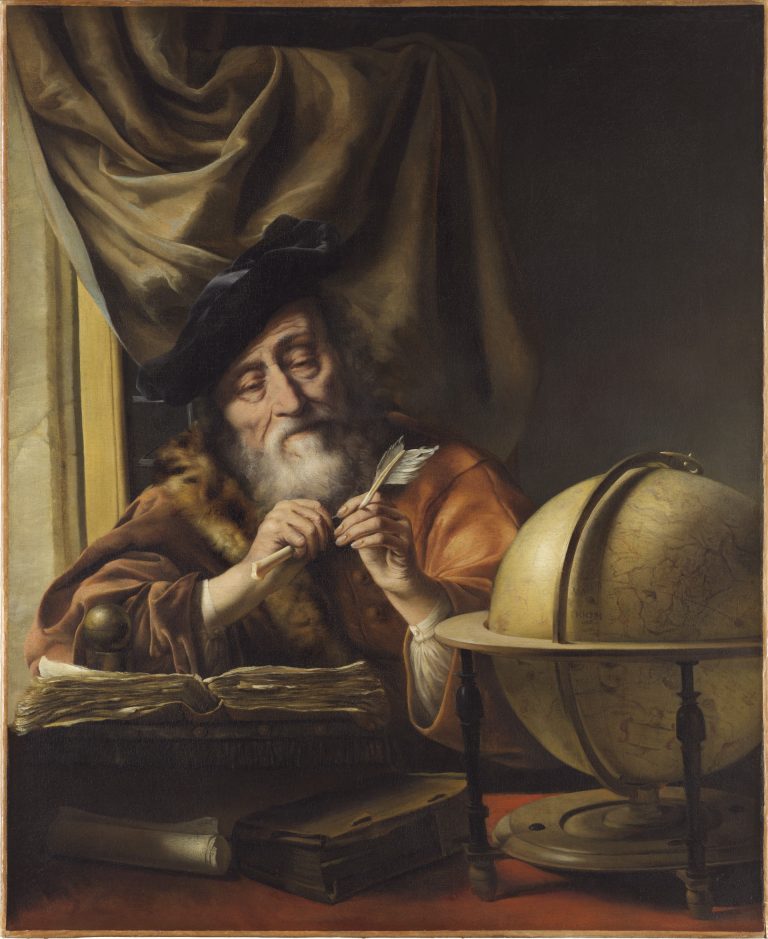Sitting beside an open window with a warm light filling his darkened study, an elderly scholar wearing a dark blue velvet beret and an amber fur-trimmed tabbaard, the traditional dress of a scholar, quietly concentrates on sharpening his quill.1 His deep-set eyes are cast downward as his fingers nimbly guide the knife’s blade across the tip of the pen. The open book lying before him suggests that that he will soon resume writing, possibly about worldly matters since a large terrestrial globe stands on the table to his left. Behind him, a thick brown curtain has been swept over the windowpane, its heavy folds rendered in broad, sweeping brushstrokes.
The pictorial character of Scholar in His Study reflects the influence of Ferdinand Bol (1616–80), with whom the German-born Godfrey Kneller apprenticed in Amsterdam in the mid-1660s.2 Bol represented a scholar in his study several times in the 1640s and 1650s, as in the Leiden Collection’s Man with a Book, 1644 (FB-100), and Old Man with a Globe, ca. 1650, in the Hermitage (fig 1).3 Bol’s intimate compositions, delicate rendering of the details of the scholars’ dress and attributes, and his subtle use of chiaroscuro provided Kneller with a compositional and stylistic models. Kneller likewise took great care in rendering the various textures of fabric and the way that light falls over its surfaces, evident, for example, in the highlights that reveal the softness of the velvet beret. Kneller’s tightly cropped composition and the frontal pose of the scholar contribute to the painting’s immediacy, as does his assured, vibrant brushwork.
The theme of a scholar sharpening his quill was introduced to Dutch art in Leiden by Gerrit Dou (1613–75) in the late 1620s.4 Dou’s pupil Frans van Mieris (1635–81) depicted the subject in the early 1650s (fig 2), a painting that Kneller may have known from his student years in Leiden.5 Much as with Kneller’s scholar, Van Mieris’s bearded, elderly scholar sharpens his quill with great concentration and patience. He is situated within a stone niche and is seated before a table with a large, open book and a globe. A curtain has been pulled aside to reveal the scene, evoking a sense of intimacy that Kneller has similarly conveyed. The theme of the quill cutter served as an emblem of diligent practice, forming, together with education and natural talent, the ideal components of a scholar’s—or artist’s—training.6 The diligence with which the scholar performs his task makes him a model of scholarly virtue.7
Early in his career Kneller portrayed the theme of a scholar in his study on a number of occasions.8 In the Bader collection’s A Scholar in an Interior, ca. 1668, he similarly depicted the elderly scholar seated in the foreground of his image.9 Kneller also represented the scholar in his study in paintings in Lübeck and Paris (fig 3).10 In the Louvre painting the scholar looks thoughtfully into the distance, his gaze passing by a table filled with books, a globe, a musical instrument, armor, a skull and a candle. This work differs from Scholar in His Study in the complexity of its composition and in its vanitas connotations. The relative simplicity of the composition of the Leiden Collection painting suggests that this charmingly atmospheric work was among the first of Kneller’s portrayals of scholars that he made in the late 1660s.
